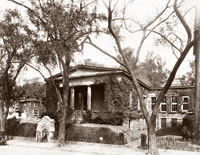Lovecraft’s Providence
Lovecraft could also be found trailing his hero Poe at the Providence Athenaeum at 251 Benefit Street. One of the oldest subscription libraries in the United States, the Athenaeum existed for more than a century prior to the 1838 construction of the Greek Revival building now housing it. Lovecraft haunted the stacks in the library for years, and the wonderful nineteenth-century building houses work by Lovecraft and Poe, including a copy of the American Review in which Poe signed his name under his anonymous poem ”Ulalume.”
Less chilling is the quirky Providence Art Club at 11 Thomas Street. This whimsical collection of historic buildings is beautiful on its own, and the exhibits of local artists attracted Providence’s upper crust, as well as the unfortunately impoverished Lovecraft. He was so taken by the Fleur-de-Lys studio building (at 7 Thomas) that he housed his doomed artist Henry Wilcox in the building in his novelette The Call of Cthulhu. Lovecraft described the Tudor Revival building as, “a hideous Victorian imitation of seventeenth century Breton Architecture which flaunts its stuccoed front amidst the lovely colonial houses on the ancient hill,” in his story, but it’s actually quite nice, and on the National Register of Historic Places.
Lovecraft was a study in the abject—he simultaneously loved his city, and loathed everything it was becoming, and he was as obsessed with the beauty of Providence as he was repulsed by its evolution into a multicultural city with a substantial non-WASP working class. Lovecraft was born in 1890 at 454 Angell Street, in his grandfather’s mansion. The building and grounds were enormous, and Lovecraft began his love affair with the written word in the building’s “third story trunk-room,” which housed a collection of nineteenth- and eighteenth-century texts. Here Lovecraft read Hawthorne and a 1717 translation of Ovid’s Metamorphoses by Sir Samuel Garth, fueling his love of the fantastic and also ultimately informing his peculiar and purposefully anachronistic writing style. But this idyll would not last. The family was torn apart by death, mental illness, and economic misfortune, and soon Lovecraft found himself in greatly reduced circumstances. It was always his dream to buy 454 Angell and reclaim his own history, and the history of his illustrious Providence family, for himself, but it was not to be. Pulp fiction could hardly pay the bills, much less fund the purchase of such a house. The home was torn down in 1961 and replaced by an apartment complex.
If there is a trace of Lovecraft left in the area, it’s at Books on the Square at 471 Angell Street. A smaller independent bookstore, Books on the Square nonetheless features an eclectic selection of current titles, and more than a few collections of Lovecraft’s work. The store touts itself as “dog-friendly,” is close to a Starbucks, and has won several accolades from the local media as the best independent bookstore in Providence. What would Lovecraft think? He would certainly enjoy seeing his work available so close to what he always thought of his home, despite the modernization of the neighborhood.
Lovecraftiana can also be found at Cellar Stories Bookstore at 111 Mathewson, Rhode Island’s largest rare and used bookstore. Ironically located on the second floor of a building, Cellar Books sells used and rare books of all types, and has a substantial Lovecraft section, including fanzines and material from small press publishers such as Arkham House and Necronomicon Press.
More modern used bookstores in Providence include Ada Books at 717 Westminster Street, which features zines and literary fiction, and Myopic Books at 5 South Angell Street in Wayland Square. Myopic Books’ name is another ironic one, as the selection is anything but. Myopic’s selection reflects its proximity to Brown University—philosophy, poetry, and architecture sections are good, and there is plenty of Lovecraft, who is also listed as one of Myopic’s desired subjects for those looking to sell.








